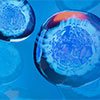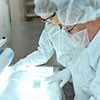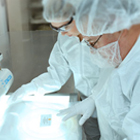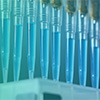Bis(3-nitrophenyl)disulfid
Artikel-Nr:
(BOSSBS-7945R-A488)
Lieferant:
Bioss
Hersteller-Artikelnummer::
BS-7945R-A488
Lokale Artikelnummer::
BOSSBS-7945R-A488
Beschreibung:
ABHD14B has hydrolase activity towards p-nitrophenyl butyrate (in vitro). It may activate transcription. There are 2 isoforms produced by alternative splicing.
VE:
1 * 100 µl
Artikel-Nr:
(BOSSBS-7945R-A350)
Lieferant:
Bioss
Hersteller-Artikelnummer::
BS-7945R-A350
Lokale Artikelnummer::
BOSSBS-7945R-A350
Beschreibung:
ABHD14B has hydrolase activity towards p-nitrophenyl butyrate (in vitro). It may activate transcription. There are 2 isoforms produced by alternative splicing.
VE:
1 * 100 µl
Lieferant:
Thermo Scientific
Beschreibung:
Ethyl-2-nitrobenzoylacetate 97%
Lieferant:
SIGMA ALDRICH MICROSCOPY
Beschreibung:
Naphthol blue black (NBB) is an textile diazo dye, with high photo- and thermal-stability. Photoelectrochemical degradation of this dye yields colorless quinone as end product. Pure grade of NBB is generally used for dyeing foodstuffs, drugs and cosmetics. It is also used as a protein stain in chromatography and electrophoresis and as a biological stain. Commercial grade of NBB is a widely used textile dye. It is used in dyeing wool, nylon, silk and in textile printing. In addition, it is also employed for colouring of soaps, anodised aluminum and casein, wood stains and writing ink preparation.
Artikel-Nr:
(BLDPBD209696-5G)
Lieferant:
BLD PHARMATECH GMBH
Hersteller-Artikelnummer::
BD209696-5G
Lokale Artikelnummer::
BLDPBD209696-5G
Beschreibung:
2-Fluor-3-nitrophenylboronsäurepinakolester 95%
VE:
1 * 5 g
Lieferant:
APOLLO SCIENTIFIC
Beschreibung:
3'-Nitroformanilid 98%
Lieferant:
APOLLO SCIENTIFIC
Beschreibung:
5-Fluoro-2-(2,2,2-trifluoroethoxy)nitrobenzene
Artikel-Nr:
(BLDPBD20954-250MG)
Lieferant:
BLD PHARMATECH GMBH
Hersteller-Artikelnummer::
BD20954-250MG
Lokale Artikelnummer::
BLDPBD20954-250MG
Beschreibung:
N-Fmoc-3-nitro-D-phenylalanine 98%
VE:
1 * 250 mg
Artikel-Nr:
(BOSSBS-13528R-A647)
Lieferant:
Bioss
Hersteller-Artikelnummer::
BS-13528R-A647
Lokale Artikelnummer::
BOSSBS-13528R-A647
Beschreibung:
G protein-coupled receptors (GPRs) are a protein family of transmembrane receptors that transmit an extracellular signal (ligand binding) into an intracellular signal (G protein activation). GPR signaling is an evolutionarily ancient mechanism used by all eukaryotes to sense environmental stimuli and mediate cell-cell communication. GPRs all have seven membrane-spanning domains and extracellular loops that can be glycosylated. These extracellular loops also contain two highly conserved cysteine residues which create disulfide bonds to stabilize the receptor structure. SREB1 (super conserved receptor expressed in brain 1), also known as GPR27 (G protein-coupled receptor 27), belongs to the SREB subfamily of GPRs that are expressed in the central nervous system. SREB1 may function as an amine-like GPR.
VE:
1 * 100 µl
Artikel-Nr:
(BOSSBS-9500R-CY3)
Lieferant:
Bioss
Hersteller-Artikelnummer::
BS-9500R-CY3
Lokale Artikelnummer::
BOSSBS-9500R-CY3
Beschreibung:
Hemostasis following tissue injury involves the deployment of essential plasma procoagulants (prothrombin, and factors X, IX, V, and VIII), which are involved in a blood coagulation cascade that leads to the formation of insoluble fibrin clots and the promotion of platelet aggregation (1-3). Coagulation factor IX (plasma thromboplastic component, F9, F.IX, HEMB) is a vitamin K-dependent, single chain serine protease that is synthesized in the liver and circulates as an inactive precursor (3,4). Factor XIa mediated proteolytic cleavage of factor IX generates factor IXa, an active serine protease composed of a 145 amino acid light chain and a 236 amino acid catalytic heavy chain, linked through disulfide bonds (5). Genetic alterations at the Factor IX locus such as point mutations, insertions and deletions, can lead to hemophilia B, also known as Christmas disease (6).
VE:
1 * 100 µl
Artikel-Nr:
(BOSSBS-13131R-HRP)
Lieferant:
Bioss
Hersteller-Artikelnummer::
BS-13131R-HRP
Lokale Artikelnummer::
BOSSBS-13131R-HRP
Beschreibung:
The complement pathway is an important host defense system that contributes to both innate and acquired immunity. There are three pathways of complement activation: the classical pathway, lectin pathway and alternative pathway. Complement protein Factor I is a key serine protease that modulates the complement cascade by regulating the levels of C3 convertases. It circulates in plasma as a heavily N-glycosylated heterodimer made up of two disulfide linked chains, each carrying three N-linked oligosaccharide chains that may have both structural and functional roles in the interactions with the natural substrate and the cofactor during catalysis. Factor I is a serine protease with a high degree of specificity for C3b and C4b. It requires protein cofactors for cleavage of these complement proteins; Factor H, CR1 or MCP are required for C3b cleavage, and C4bp or CR1 are required for C4b cleavage.
VE:
1 * 100 µl
Artikel-Nr:
(BOSSBS-13131R-A488)
Lieferant:
Bioss
Hersteller-Artikelnummer::
BS-13131R-A488
Lokale Artikelnummer::
BOSSBS-13131R-A488
Beschreibung:
The complement pathway is an important host defense system that contributes to both innate and acquired immunity. There are three pathways of complement activation: the classical pathway, lectin pathway and alternative pathway. Complement protein Factor I is a key serine protease that modulates the complement cascade by regulating the levels of C3 convertases. It circulates in plasma as a heavily N-glycosylated heterodimer made up of two disulfide linked chains, each carrying three N-linked oligosaccharide chains that may have both structural and functional roles in the interactions with the natural substrate and the cofactor during catalysis. Factor I is a serine protease with a high degree of specificity for C3b and C4b. It requires protein cofactors for cleavage of these complement proteins; Factor H, CR1 or MCP are required for C3b cleavage, and C4bp or CR1 are required for C4b cleavage.
VE:
1 * 100 µl
Artikel-Nr:
(BOSSBS-11175R-A555)
Lieferant:
Bioss
Hersteller-Artikelnummer::
BS-11175R-A555
Lokale Artikelnummer::
BOSSBS-11175R-A555
Beschreibung:
Lubricin, also designated proteoglycan-4 or megakaryocyte stimulating factor, is important for boundary lubrication within articulating joints. It is a disulfide-linked homodimer (between Cysteine 1146 and Cysteine 1403) that is essential for protein cleavage. Lubricin inhibits synovial cell adhesion to the cartilage surface, but also prevents the deposition of proteins from synovial fluid onto cartilage. Lubricin is highly expressed in cartilage, liver and synovial tissue. Defects in the gene encoding for lubricin can cause Jakobs syndrome, also designated camptodactyly-arthropathy-coxa vara-pericarditis syndrome (CACP). CACP is an autosomal recessive disorder characterized by joint failure associated with noninflammatory synoviocyte hyperplasia and subinitimal fibrosis of the synovial capsule. Lubricin undergoes different levels of glycosylation and may be detected at varying molecular weights.
VE:
1 * 100 µl
Artikel-Nr:
(BOSSBS-11175R-CY3)
Lieferant:
Bioss
Hersteller-Artikelnummer::
BS-11175R-CY3
Lokale Artikelnummer::
BOSSBS-11175R-CY3
Beschreibung:
Lubricin, also designated proteoglycan-4 or megakaryocyte stimulating factor, is important for boundary lubrication within articulating joints. It is a disulfide-linked homodimer (between Cysteine 1146 and Cysteine 1403) that is essential for protein cleavage. Lubricin inhibits synovial cell adhesion to the cartilage surface, but also prevents the deposition of proteins from synovial fluid onto cartilage. Lubricin is highly expressed in cartilage, liver and synovial tissue. Defects in the gene encoding for lubricin can cause Jakobs syndrome, also designated camptodactyly-arthropathy-coxa vara-pericarditis syndrome (CACP). CACP is an autosomal recessive disorder characterized by joint failure associated with noninflammatory synoviocyte hyperplasia and subinitimal fibrosis of the synovial capsule. Lubricin undergoes different levels of glycosylation and may be detected at varying molecular weights.
VE:
1 * 100 µl
Artikel-Nr:
(BOSSBS-11175R-A350)
Lieferant:
Bioss
Hersteller-Artikelnummer::
BS-11175R-A350
Lokale Artikelnummer::
BOSSBS-11175R-A350
Beschreibung:
Lubricin, also designated proteoglycan-4 or megakaryocyte stimulating factor, is important for boundary lubrication within articulating joints. It is a disulfide-linked homodimer (between Cysteine 1146 and Cysteine 1403) that is essential for protein cleavage. Lubricin inhibits synovial cell adhesion to the cartilage surface, but also prevents the deposition of proteins from synovial fluid onto cartilage. Lubricin is highly expressed in cartilage, liver and synovial tissue. Defects in the gene encoding for lubricin can cause Jakobs syndrome, also designated camptodactyly-arthropathy-coxa vara-pericarditis syndrome (CACP). CACP is an autosomal recessive disorder characterized by joint failure associated with noninflammatory synoviocyte hyperplasia and subinitimal fibrosis of the synovial capsule. Lubricin undergoes different levels of glycosylation and may be detected at varying molecular weights.
VE:
1 * 100 µl
Artikel-Nr:
(BOSSBS-9501R-HRP)
Lieferant:
Bioss
Hersteller-Artikelnummer::
BS-9501R-HRP
Lokale Artikelnummer::
BOSSBS-9501R-HRP
Beschreibung:
Hemostasis following tissue injury involves the deployment of essential plasma procoagulants (Prothrombin and Factors X, IX, V and VIII), which are involved in a blood coagulation cascade that leads to the formation of insoluble Fibrin clots and the promotion of platelet aggregation. Coagulation Factor X (Stuart Prower factor, FX, F10) is a vitamin K-dependent, single chain serine protease that is synthesized in the liver and circulates as an inactive precursor. The mature form of Factor X (Factor X A) is generated by Factor IX A- or Factor VII A-mediated cleavage at the tripeptide sequence, Arg-Lys-Arg, to yield a disulfide linked dimer. Together with the cofactor Factor V A and Ca2+ on the surface of platelets or endothelial cells, Factor X A coordinates as part of the prothrombinase complex, which mediates proteolysis of Prothrombin into active Thrombin. Mutations at the Factor X locus resulting in Factor X deficiencies can contribute to hemorrhagic diathesis.
VE:
1 * 100 µl
Preis auf Anfrage
Lager für diesen Artikel ist begrenzt, kann aber in einem Lagerhaus in Ihrer Nähe zur Verfügung. Bitte stellen Sie sicher, dass Sie in sind angemeldet auf dieser Seite, so dass verfügbare Bestand angezeigt werden können. Wenn das
Lager für diesen Artikel ist begrenzt, kann aber in einem Lagerhaus in Ihrer Nähe zur Verfügung. Bitte stellen Sie sicher, dass Sie in sind angemeldet auf dieser Seite, so dass verfügbare Bestand angezeigt werden können. Wenn das
Dieses Produkt kann nur an eine Lieferadresse versandt werden die über die entsprechende Lizenzen verfügt. Für weitere Hilfe bitte kontaktieren Sie Ihr VWR Vertriebszentrum.
-Additional Documentation May be needed to purchase this item. A VWR representative will contact you if needed.
Dieses Produkt wurde von Ihrer Organisation gesperrt. Bitte kontaktieren Sie Ihren Einkauf für weitere Informationen.
Dieses Produkt ist Ersatz für den von Ihnen gewünschten Artikel.
Dieses Produkt ist nicht mehr verfügbar. Bitte kontaktieren Sie den VWR Kundenservice.
|
|||||||||

















































